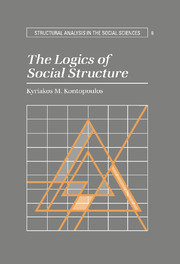Book contents
- Frontmatter
- Contents
- Preface
- Introduction
- Part I Metatheoretical considerations
- Part II Compositionist logics
- Part III Logics of hierarchy
- Part IV Heteracrchical logics
- 10 Heterarchical thinking in social thought
- 11 Neural networks as a model of structure
- Part V The phenomenology of social structures
- Appendix: The logics of structuration
- Glossary
- Bibliography
- Index
11 - Neural networks as a model of structure
Published online by Cambridge University Press: 24 October 2009
- Frontmatter
- Contents
- Preface
- Introduction
- Part I Metatheoretical considerations
- Part II Compositionist logics
- Part III Logics of hierarchy
- Part IV Heteracrchical logics
- 10 Heterarchical thinking in social thought
- 11 Neural networks as a model of structure
- Part V The phenomenology of social structures
- Appendix: The logics of structuration
- Glossary
- Bibliography
- Index
Summary
In this chapter we are going to embark on a speculative journey – so, caveat emptor! There are some fascinating developments taking place in the fields of cognitive science and neuroscience that may hold the key to a radically new understanding of a host of fundamental problems in a variety of disciplines and provide new leads in philosophical thinking as well. I am referring to the exciting field of neural network research, which appears to be on the verge of revolutionizing our understanding of “dualisms” or of “dualities,” such as the relationship between brain and mind. My intentions in this chapter are simply to explore some possibilities implicit in the neural network model for rethinking our conception of “structure” in general, and suggesting, more particularly, a new approach to the theory of social structure. The insights derived from the neural network literature are only orienting analogies at this stage of our research. I do not make the claim that they provide a coherent new theory, only that, if correct, they would add significant new lines of argumentation on behalf of the heterarchical model of structure as it was developed in the previous chapter (which stands on its own, without any need for reference to neural networks). There is a very serious assumption here – one that can be modified by analytical means as we shall see later – that in order for the model of neural networks to be useful, one must accept, at least temporarily as if by a phenomenological bracketing, that there is no significant discontinuity between natural and social phenomena and, thus, between “natural structures” and “social structures.”
Information
- Type
- Chapter
- Information
- The Logics of Social Structure , pp. 243 - 268Publisher: Cambridge University PressPrint publication year: 1993
Accessibility standard: Unknown
Why this information is here
This section outlines the accessibility features of this content - including support for screen readers, full keyboard navigation and high-contrast display options. This may not be relevant for you.Accessibility Information
- 3
- Cited by
